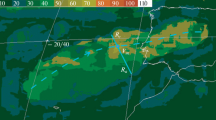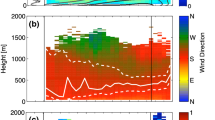Abstract
During field experiments using surface weather stations and a Sodar-RASS (radio acoustic sounding system) combination, low-level jets were observed in the Colima Valley of central western Mexico. These low-level jet events have not been previously observed in this part of the tropics. The present study focuses on events from one specific field period from December 2011 to April 2013 performed at a specific location. From this dataset, it was found that these phenomena typically develop at night at around 0300 local time and they reach their maximum speed 20 min after sunrise and end at 1100 local time. For the considered period, low-level jet events occurred during 88 % of nights, and most of these events were fully characterized; thus, 73 % of the nights presented with categorized low-level jets following the classical literature on this mesoscale phenomenon in other parts of the world. The low-level wind maxima occurred with events ranging from category sub-zero to category 3. The strongest category 3 events are around 25 m s\(^{-1}\) and the longest event was 57.5 h, but they are more typical of category 1. Their average speed is 11.7 m s\(^{-1}\) and their height distribution is bimodal, with a group of events occurring at lower levels, with an average height of 190 m; higher levels have a mean height of 480 m. The higher cases are more typical of the rainy season. During all seasons, their direction is predominantly from the north-north-west to north-north-east with some dispersion occurring during the rainy season. The region of study is typically considered to have low wind speeds in the atmospheric boundary layer, making these events super-geostrophic.








Similar content being viewed by others
References
Anderson BT, Roads JO, Chen S-C, Juang H-MH (2001) Model dynamics of summertime low-level jets over northwestern Mexico. J Geophys Res 106(D4):3401–3413
Arfeuille G, Quintanilla-Montoya AL, Zizumbo Villarreal L, Viesca Gonzalez FC (2012a) Methodology toward a long/term realistic wind ressource assessment applied in Colima Valley, Mexico. In: Third conference on weather, climate, and the new energy economy, 92nd american meteorological society annual meeting. Available on-line: https://ams.confex.com/ams/92Annual/webprogram/Paper202758.html
Arfeuille G, Quintanilla-Montoya AL, Zizumbo Villareal L, Viesca Gonzalez FC (2012b) Wind resource assessment in a tropical region with complex terrain using sodar and a meteorological tower network to measure low level jets and boundary layer conditions. In: 15th AMS conference on mountain meteorology. Available on-line: https://ams.confex.com/ams/15MountMet/webprogram/Manuscript/Paper210184/ARFEUILLLE_etal_15MountMetConf_Aug2012.pdf
Arfeuille G, Rögnvaldsson O, Quintanilla-Montoya AL, Ágústsson H, Zizumbo Villareal L, Jónasson K, Viesca Gonzalez FC (2013) Enhanced wind assessment and forecast using sodar/rass and mesoscale modeling. In: ICEM 2013: international conference on energy and meteorology. Available on-line: http://www.icem2013.org/wp-content/uploads/2013/08/17_GillesArfeuille.pdf
Baas P, Bosveld FC, Baltink HK, Holtslag AAM (2009) A climatology of nocturnal low-level jets at Cabauw. J Appl Meteorol Climatol 48:1627–1642
Banta RM, Newsom K, Lundquist JK, Pichugina YL, Coulter RL, Mahrt L (2002) Nocturnal low-level jet characteristics over Kansas during CASES-99. Bound-Layer Meteorol 105:221–252
Banta RM (2008) Stable-boundary-layer regimes from the perspective of the low-level jet. Acta Geophys 56:58–87
Blackadar AK (1957) Boundary layer wind maxima and their significance for the growth of nocturnal inversions. Bull Am Meteorol Soc 38:283–290
Bohren CF, Albrecht BA (1998) Atmospheric thermodynamics. Oxford University Press, Oxford, 402 pp
Bonner WD (1968) Climatology of the low level jet. Mon Weather Rev 96:833–850
Castro CLS, Pielke RA, Adegoke JO (2007a) Investigation of the summer climate of the contiguous U.S. and Mexico using the Regional Atmospheric Modeling System (RAMS): part I: Model climatology (1950–2002). J Clim 20:3844–3865
Castro CLS, Pielke RA, Adegoke JO, Schubert SD, Pegion PJ (2007b) Investigation of the summer climate of the contiguous U.S. and Mexico using the Regional Atmospheric Modeling System (RAMS): part II: Model climate variability. J Clim 20:3866–3887
Corfidi SF, Merritt JH, Fritsch JM (1996) Predicting the movement of mesoscale convective complexes. Weather Forecast 11:41–46
Corfidi SF (2003) Cold pools and MCS propagation: forecasting the motion of downwind-developing MCSs. Weather Forecast 18:997–1017
Gouault J (1938) Vents en altitude Fort Lamy (Tchad). Annales de Physique du Globe de France et d’Outre-Mer 5:70–91
Higgins W, Gochis D (2007) Synthesis of results from the North American monsoon experiment (NAME) process study. J Clim 20:1601–1607
Holton JR (1967) The diurnal boundary layer wind oscillation above sloping terrain. Tellus 19:199–205
Indeje M, Semazzi FHM, Xie L, Ogallo LJ (2001) Mechanistic model simulations of the East African climate using NCAR regional climate model: influence of large-scale orography on the Turkana low-level jet. J Clim 12:2710–2724
Jiang X, Lau NG, Held IM, Ploshay JJ (2007) Mechanisms of the Great Plains low-level jet as simulated in an AGCM. J Atmos Sci 64:532–547
Kelley ND, Jonkman BJ, Scout GN (2007) Pichugina YL (2007) Comparing LIDAR with Sodar and Direct Measurements for Wind Assessment. American Energy Association, Wind Power 2007, Colombia
Lin YL (2007) Mescoscale dynamics. Cambridge University Press, New York 630 pp
Lundquist JK (2003) Intermittent and elliptical inertial oscillations in the atmospheric boundary layer. J Atmos Sci 60:2661–2673
Macklin SA, Bond NA, Walker JP (1990) Structure of a low level jet over lower Cook Inlet, Alaska. Mon Weather Rev 118:2568–2578
Means LL (1952) On thunderstorm forecasting in the central United States. Mon Weather Rev 80:165–189
Nesbitt SW, Cifelli R, Rutledge SA (2006) Storm morphology and rainfall characteristics of TRMM precipitation features. Mon Weather Rev 134:2702–2721
Rife DL, Pinto JO, Monaghan AJ, Davis CA, Hannon JR (2010) Global distribution and characteristics of diurnally varying low-level jets. J Clim 23:5041–5064
Ruane AC (2010) NARR’s atmospheric water cycle components. Part II: summertime mean and diurnal interactions. J Hydrometeorol 11:1220–1233
Small RJO, de Szoeke SP, Xie SP (2007) The Central American mid-summer drought: Regional aspects and large scale forcing. J Clim 20:4147–4159
Smith RK, Spengler T (2011) The dynamics of heat lows over elevated terrain. Q J R Meteorol Soc 137:250–263
Song J, Liao K, Coulter RL, Lesht BM (2005) Climatology of the low-level jet at the Southern Great Plains atmospheric boundary layer experiment site. J Appl Meteoro 44:1593–1606
Staffell I (2012) Wind Turbine power curves. Imperial College London, UK. Available on-line: http://www.academia.edu/1489838/Wind_Turbine_Power_Curves
Stensrud DJ (1996) Importance of low-level jets to climate: a review. J Clim 9:1698–1711
Stull RB (1988) An Introduction to boundary layer meteorology. Kluwer Academic Publishers, Dordrecht 670 pp
Tsakraklides G, Evans JL (2003) Global and regional diurnal variations of organized convection. J Clim 16:1562–1572
Vera C et al (2006) Toward a unified view of the American monsoon systems. J Clim 19:4977–5000
Whiteman CD, Bian X, Zhong S (1997) Low-level jet climatology from enhanced rawinsonde observations at a site in the Southern Great Plains. J Appl Meteorol 36:1363–1376
Wu Y, Raman S (1997) Effect of land-use pattern on the development of low-level jets. J Appl Meteorol 36:573–590
Acknowledgments
Partial funding for this work was provided by Conacyt under grants #40108 and #6490 for surface stations, and funding from SEP-PIFI 2008-2009 combined with COEPES-2008 for the Sodar-RASS system. The latter not only made the present study possible, but it also allowed our undergraduate students to get involved in the use of remote sensing tools. The authors are especially grateful to the CFE energy transmission department, who granted us access to the main monitoring site. Finally, the first author gratefully acknowledges Robert Drouhin, who will be greatly missed. His constant enthusiasm and interest during our many discussions constantly fuelled our motivation.
Author information
Authors and Affiliations
Corresponding author
Rights and permissions
About this article
Cite this article
Arfeuille, G., Quintanilla-Montoya, A.L., Viesca González, F.C. et al. Observational Characteristics of Low-Level Jets in Central Western Mexico. Boundary-Layer Meteorol 155, 483–500 (2015). https://doi.org/10.1007/s10546-015-0005-0
Received:
Accepted:
Published:
Issue Date:
DOI: https://doi.org/10.1007/s10546-015-0005-0




